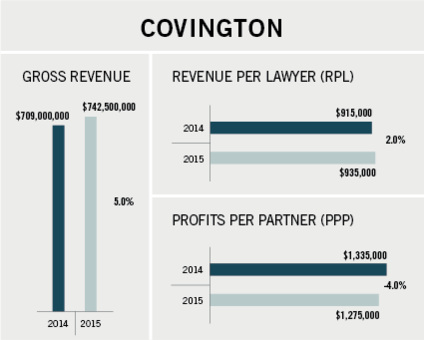
Yet profits per partner sunk 4 percent, to $1,275,000, or a $60,000 decrease from 2014, the firm told The National Law Journal this month.
“When I think about the year, I focus on a number of the very important landmarks the firm has achieved,” chairman Timothy Hester said. “There’s been this ongoing growth from within.”
Hester began his third term as chairman in January. The term will last four years. At the time of his re-election in October—which also marked the start of the firm’s 2016 fiscal year—Covington was glowing from a series of strategic plays it made last year.
The firm hired a group of five well-known government contracts partners from McKenna Long & Aldridge, which was acquired by Dentons. The group almost immediately helped Covington broaden its representation of Northrop Grumman Corp. on bid-protest cases and of contractor KBR Inc., Hester said.
The firm also moved its San Diego office to Los Angeles for an expanded West Coast presence and spent its first full year in a crown-jewel City Center office building in downtown Washington, its headquarters.
The investments hit the profits numbers somewhat, Hester said. Profitability declined because of another reason as well, he said, citing the promotions of 15 lawyers to the equity partnership at the beginning of the 2015 fiscal year, and another nine in October.
In 2015, Covington’s total lawyers rose by 19 full-time positions, to 793. The one-tier equity partnership jumped from 248 lawyers to 256.5, a 3 percent increase, the firm said.
“There’s no doubt that numerically, if you’re growing like that, it affects your averages” in profits per partner, Hester said. “But my view is it’s extremely important.”
Hester calls the approach “building for the future.” The short-termism that pervades the legal industry through frequent firm mergers and lateral moves hasn’t shaken Covington, he added.
“I think people obviously want the numbers to improve, and we think we will continue to improve them,” Hester said. But partners “recognize the overall philosophical proposition of investing in the future of the firm.”
Several Covington lawyers who became government lawyers have returned to the firm in recent years, including one of the biggest hires among private-practice law in Washington last year: former Attorney General Eric Holder Jr.
“They all came back, so there is a strong support for the orientation of the firm toward having a long view on what we’re trying to accomplish,” Hester said of Holder and other former Justice Department and executive branch lawyers.
He also named practices that have relied on former Covington associates who are now among the new partner class. Products liability attorneys Paul Schmidt and Phyllis Jones, for instance, represented long-time Covington client Eli Lilly & Co. in four trials last year, Hester said.
“They’re fantastic trial lawyers, and they’ve grown up with us,” Hester said. “It reflects upon the point that we’re trying to grow for the long haul.”
The firm had to rethink its approach to one area last year. Dan Bryant, whom Covington brought in to grow the lobbying practice, left for Wal-Mart Stores Inc. after three years at the firm. Partner John Veroneau then assumed leadership of the group.
After Bryant left, “We felt we really had the architecture and the infrastructure in place,” Hester said. “Frankly the practice has continued to do very well and didn’t skip a beat.”
This report is part of ALM’s early coverage of 2015 financial results of The Am Law 100/200. Final rankings and full results for The Am Law 100 will be published in The American Lawyer’s May 2016 issue and on AmericanLawyer.com. Am Law Second Hundred rankings will be published in the June issue.






